 |
 have never liked climbing by headlamp, but something felt very wrong that
night. My seven-member Tacoma Mountain Rescue team was following the
last radar coordinates from a missing airplane. As daylight faded into
dusk, we were moving quickly upward through a steep hillside full of
downfall and undergrowth. We picked up the faint smell of jet fuel.
After about half an hour, we were a quarter-mile from the last radar hit
and had lost the fuel smell, so we stopped to prepare for the impending
darkness. I turned on my headlamp and tried to move but couldn’t.
I was in a state of near-panic.
have never liked climbing by headlamp, but something felt very wrong that
night. My seven-member Tacoma Mountain Rescue team was following the
last radar coordinates from a missing airplane. As daylight faded into
dusk, we were moving quickly upward through a steep hillside full of
downfall and undergrowth. We picked up the faint smell of jet fuel.
After about half an hour, we were a quarter-mile from the last radar hit
and had lost the fuel smell, so we stopped to prepare for the impending
darkness. I turned on my headlamp and tried to move but couldn’t.
I was in a state of near-panic.
It was all I could do just to keep moving. The others were calling
out to potential survivors and searching for signs of the missing
airplane, but I was just trying to keep from panicking. I had an
overwhelming sense of not wanting to be there. I stayed at the back of
the group, trying to hide my emotions from my teammates. After what
seemed like an eternity, we reached the point where the radar had lost
the airplane, but found nothing. A Seattle Mountain Rescue team radioed
that they had found the wreckage about 200 yards downhill.
After taking care of business at the crash site, our team headed down.
I was still struggling with panic, but less than before and as soon as we
hit the road, I felt relief. Each of us was processing the crash site
and I was still trying to figure out why I had struggled so much in the
darkness. Along the road we unexpectedly encountered the family and
friends of the victims, sobbing, which triggered a realization: The last
time I had searched with a headlamp was looking for my own missing
friends.
Overdue Friends
Three and a half years earlier, I had joined a group from the Tacoma
Mountain Rescue Unit (TMRU) and some of their friends for
“John’s annual ice climbing trip” to the Canadian
Rockies. Because of the large group and the danger of icefall, we often
split up to do different climbs each day. That day, four of us had
climbed “Wet Dream” while the three others—John and Jim
from Tacoma Mountain Rescue and John’s friend Russ—were
planning to climb “Sniveling Gully”. If another party was on
“Sniveling Gully”, they would climb “Midnight
Rambler”. It had been a beautiful day for climbing—not a
cloud in the sky, and the ice was like plastic. That evening we returned
to the David Thompson Resort in Nordegg to prepare dinner. About an hour
after dark we started to get concerned about the others. Two of us left
to look for them while the others stayed by the phone in case they
called. We had driven for about 45 minutes when we found their car at
the approach to “Midnight Rambler”.
After quickly inspecting the car for signs of returning climbers or
car trouble, we located the path to the climb. Through the dark, we saw
tracks heading in but none coming out. Kenny and I yelled for them. We
could hear our voices echoing off the cliff walls, but there was no
response, so we packed minimal climbing gear, donned our headlamps and
started up the trail. I was in a full panic; there was no scenario I
could think of to explain why at least one of them couldn’t get
out. It hadn’t snowed in a week and a half, so avalanche danger
should be low. They were too disciplined as climbers to all have fallen
off the route. And they had three ropes with them, so one person could
rappel off if there was an injury. With my senses limited to the tunnel
view provided by the headlamp and the sound of squeaking snow, I just
wanted to turn around and run home. When the trail ended in a large pile
of avalanche debris all our questions were answered. I instantly knew my
friends were dead.
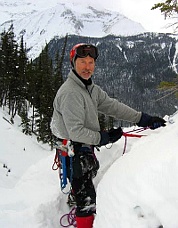 John Miner at the top of Sunwapta Right Hand, Canadian Rockies, shortly before the accident. Photo © Rick Wire. |
|
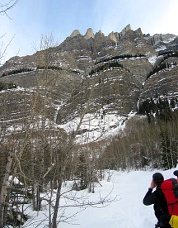 Looking up at Midnight Rambler (left-hand ice gully) on Mount Wilson. Photo © Rick Wire. |
|
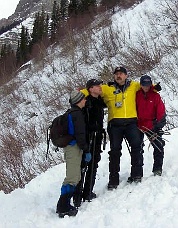 John Miner's brother Tom consoles members of Tacoma Mountain Rescue below Midnight Rambler. Photo © Mike Mixon. |
| John Miner at the top of Sunwapta Right Hand, Canadian Rockies, shortly before the accident. Photo © Rick Wire. |
|
Looking up at Midnight Rambler (left-hand ice gully) on Mount Wilson. Photo © Rick Wire. |
|
John Miner's brother Tom consoles members of Tacoma Mountain Rescue below Midnight Rambler. Photo © Mike Mixon. |
We climbed onto the debris pile and started searching. I could barely
move. It took every ounce of will-power I could muster to keep
searching. I knew my friends were dead and all I wanted to do was leave.
We continued searching, but all we found was a helmet and the rope I had
lent them that morning. Knowing our friends were likely at the ends of
the rope, I tried to pull on it, but the rope wouldn’t cut through
the snow because it was too hard. A few minutes after finding the rope,
I suggested to Kenny it was time to go get help. He began hacking at the
snow at the other end of the rope with the ice tools we brought, but his
efforts to move any snow were futile as it was hard as ice. He agreed it
was time to get help. Despite the dark, we thought we had seen the whole
debris pile. We took one last look, yelled one last time, and left for
help.
For months after the accident, I questioned everything I had done that
night. I knew nothing would have changed the outcome, but what if things
were different? Had we done everything we needed to do, or had my desire
to leave the scene clouded my decision making? I had always envisioned
myself as being calm and collected in a crisis. But in that moment of
pure instinct, between fight and flight, my instinct was flight. If one
of my friends was partially buried and breathing, but could not move,
would I have found him? It took me a long time to realize that even
though I had been fighting the urge to leave and our thought processes
were not clear, Kenny and I had assessed the situation accurately and had
made reasonable judgments.
Unexpected Transitions
The four-mile drive to the Saskatchewan Crossing ranger station seemed
to take an eternity, enough time to figure out which activities and life
goals I would quit and who I could sell my ice climbing gear to. When we
reached the ranger station, a light was on and Marie, the ranger’s
wife, answered our knock. She contacted the Parks Search and Rescue
team. Kenny took the phone to give the necessary information to the
rangers. Suddenly he handed me the phone and the ranger asked,
“You are an experienced rescuer and know what you saw. Do we need
to come tonight or can we wait until morning.” A lot of thoughts
went through my head. I knew there was no chance they were alive, or
Kenny and I wouldn’t have left the scene. But I wanted them to
come right away anyhow. I rationalized to myself that our Tacoma rescue
team would not hesitate to search in the middle of the night even if
there was no chance the subjects were alive. Still I felt awkward about
the decision to make them come out in the middle of the night.
I realized that we had switched roles. In the past, we were the
rescuers—now we were the victims. In retrospect, it surprised me
how quickly I had transitioned to the victim role, with no desire to
participate as a trained rescuer. I had previously assumed that if my
friends were injured or lost, I would want to take part in their rescue
or recovery. But now, even when asked by the Park Rangers to help them
find the location, I actively avoided participating. Part of it was
because the accident location was so obvious; there was only one car on
the Icefields Parkway and only one trail to the climb. The other part
was that I had no desire to go back to the scene or to see my
friends’ bodies. I had already visualized them as lifeless when I
was at the scene, and didn’t want to see it for real. Another
climber in our group had the opposite reaction and had to be given a task
by the rescuers to keep him out of their way.
How the Accident Happened
We later learned that the accident had been caused by an un-forecasted
temperature inversion that triggered a slab avalanche 4,000 feet above my
friends. The avalanche released from a large bowl and travelled down the
drainage, gathering more snow at each small snow field until sweeping
them off the route and depositing them at the bottom, under as much as 13
feet of concrete-hard snow.
After the bodies were recovered, one of the Park Rangers asked me
about how our friends climbed. Specifically the Ranger told me that they
had climbed the route and found no ice screws or obvious screw holes. I
told him that John always insisted that a screw be put in immediately on
each lead, and he would always remind those he was climbing with. After
that I became obsessed with figuring out exactly where they were on the
climb when the avalanche hit, in part to prove that my friends had not
made any careless climbing mistakes. I looked at pictures of their gear
and reread the route description and concluded that the climbers were
clipped to a tree or fixed anchor at the top of the climb which is why
there were no screws in the ice. Later, when Jim’s camera was
recovered, this sequence was confirmed.
The night after the recovery, a contingent from Tacoma arrived
including John’s brother Tom, a long-time mountain rescuer and
sheriff’s department search-and-rescue leader. Before we left the
Park the next day, all of us walked up to the accident site. The debris
pile was twice as big as Kenny and I had seen in the dark. Near the spot
where his brother was found, Tom called us over and gave us a very
heartfelt acknowledgement and expressed his gratitude for what we had
been through. This greatly aided my recovery from the accident. Through
all the doubts and second-guessing of the following months, I continually
fell back on Tom’s words and knew that, in his eyes, we had done
all we could.
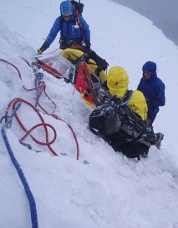 TMRU team securing a patient in a litter on steep snow. TMRU photo. | |
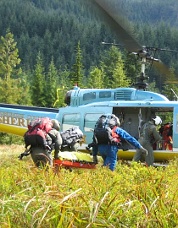 TRMU volunteers undergoing helicopter training. TMRU photo. |
|
 Chinook helicopter on a TMRU mission to Liberty Ridge. TMRU photo. |
| TMRU team securing a patient in a litter on steep snow. TMRU photo. |
|
TRMU volunteers undergoing helicopter training. TMRU photo. |
|
Chinook helicopter on a TMRU mission to Liberty Ridge. TMRU photo. |
Reflecting
Some critics will say that climbing is inherently selfish and
dangerous. But as an engineer, I struggled with the fact that I could
not find any significant decision-making errors that led to the accident.
The climbing community, and to an even greater extent the rescue
community, is very critical of accidents. I spent many hours assessing
what others had to say and analyzing my own thoughts from the days
leading up to the accident, but reminded myself that at the time we had
no information suggesting significant avalanche risk. Very seasoned and
critical climbers and mountain rescuers told me they couldn’t find
any significant errors made by the climbers or our group.
The only potential error was mentioned by the news media, which
criticized the climbers for not having avalanche transceivers. I had no
problem dismissing this, nor did the Park Rangers, since it would not
have changed the outcome (though it might have aided the recovery). That
being said, when I ice-climb now, I always wear a transceiver so that if
I am buried my family won’t be harassed by the press.
Six months passed before I really started to mourn my lost friends. I
saw how the loss of two very experienced leaders had left a huge hole in
Tacoma Mountain Rescue. John and Jim were close friends to many of us,
and those who knew them are constantly reminded of how much their
training skills and special dedication meant. Initially I felt a need to
fill the leadership hole, but instead found a much stronger drive to
participate on search-and-rescue missions. Unlike training sessions,
missions are unpredictable and my family is more accommodating now that
we have a greater understanding of the impact of unfortunate situations.
Prior to the accident, I thought the main goal of each
search-and-rescue mission was to help the people who were lost or
injured, while the recovery of remains was a less critical part of the
job. After the night we searched for the lost plane, I realized that
bringing out the deceased isn’t just for the victims but also to
help bring closure to the family and friends. Now I am very motivated to
bring resolution to the families and friends and I feel a bond to them I
never felt before.
Carrying On
In October, following the accident, I took my wife to where the
accident occurred. Winter had come early to the Parkway. On the ride
home, she told me she understood, from the beauty and isolation of the
area, why I liked it up there and said I could return if I wanted.
Although I will always remember that tragic night, I have returned twice
to Canada to ice-climb, though with much greater awareness of my
incomplete understanding of local snow conditions and terrain.
The accident has truly changed me as a father, husband, and climber.
Some of those changes were already in process because life is, after all,
a moving target. But the accident accelerated them. Prior to the
accident, I was obsessed with bagging the 100 highest peaks in
Washington, while now my focus is on introducing the mountains to my
kids. Now that they ski, I have pretty much hung up my backcountry skis
in favor of lift-area skis and a snowboard. But once they get older, I
can’t wait to share the backcountry with them. Whether searching
in the dark for a lost person, skiing or backpacking with my wife and
kids, or enjoying a backcountry adventure with friends, I can’t imagine
losing my need to experience the mountains.
|
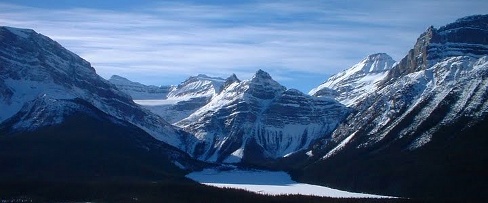 Near Bow Summit on the Icefields Parkway, Canadian Rockies. Photo © Rick Wire. |
|
| |
Near Bow Summit on the Icefields Parkway, Canadian Rockies. Photo © Rick Wire. |
|
|

|
| Summary |
|
 |
| The Accident
|
 |
|
Climbers:
John Miner
Jim Andrues
Russ Howard
Date:
February 12, 2004
Location:
“Midnight Rambler” (240m, III, WI 3) on Mount Wilson, Banff National Park, Alberta.
|
 |
| Accident Scenario
|
 |
|
The three climbers were caught and killed by an avalanche,
apparently while climbing the third pitch of the route.
The weather on the day of the accident was clear with no wind.
Unknown to the climbers, a temperature inversion had settled into the
area. The temperature where they were climbing was 20 to 35°F,
similar to previous days, but was estimated by Park Wardens to be
54°F where the avalanche originated. No significant snow had fallen
during the previous week.
In early afternoon, multiple slab avalanches released from an
acre-sized snowfield at about 9,500ft that wasn’t visible from
the route or the road. It funneled into the ravine above
“Midnight Rambler” and traveled about 4,000 vertical feet
before overtaking the climbers.
All three climbers were swept about 400 feet to the bottom of the
route and buried. The resulting debris zone was about 300 by 200
feet and 15-30 feet deep.
|
 |
| Remembering John, Jim and Russ
|
 |
|
• John Miner
John Miner, 53, was a police Lieutenant in Redmond, Washington, where he had served for over 25 years. He was an operations leader and lead instructor in the all-volunteer Tacoma Mountain Rescue Unit (TMRU). John was an accomplished mountaineer, having climbed in the Cascades, Peru, and the Himalaya. He was survived by his mother, father and brother.
• Jim Andrues
Jim Andrues, 66, of Tacoma, Washington, was a Pierce County Deputy Sheriff. He was also a TMRU team leader. Both Miner and Andrues were involved in high-profile searches, including the successful recovery of a missing skier at Alpental (Dan Witkowski) just weeks before their deaths.
• Russ Howard
Russ Howard, 42, was a traffic signal technician for the City of Redmond, Washington. He was said to have two great passions—his family and being on the mountain. Russ was survived by his wife, two daughters and two sons.
|
 |
| Rescue Units In Washington
|
 |
|
• Bellingham Mountain Rescue
Operates primarily in the western Cascades between the North Cascades Highway and the Canadian border.
• Central Washington Mountain Rescue
Based in Yakima, this unit operates primarily in the southeastern Washington Cascades.
• Chelan County Mountain Rescue Association
Based in Wenatchee, this unit operates primarily in the eastern Cascades in Chelan County.
• Everett Mountain Rescue
Operates primarily in the western Cascades in Snohomish County.
• North Country Volcano Rescue Team
Based in Yacolt, this unit has operated on Mount St. Helens since it reopened to climbers in 1987.
• Olympic Mountain Rescue
Based in Bremerton, this unit operates primarily in the Olympic Mountains.
• Seattle Mountain Rescue
Operates primarily in the western Cascades in King County.
• Skagit Mountain Rescue
Based in Mount Vernon, this unit operates primarily in the western Cascades in Skagit County.
• Spokane Mountaineers Search and Rescue
Operates primarily in Spokane County and neighboring areas.
• Tacoma Mountain Rescue
Operates primarily on Mount Rainier and other areas of the western Cascades in Pierce County.
|
 |
| Rescue Units In Oregon
|
 |
|
• Corvallis Mountain Rescue Unit
Operates out of Benton County in western Oregon.
• Deschutes County Sheriff's Search and Rescue
Based in Bend, operates primarily on the east side of the Oregon Cascades.
• Eugene Mountain Rescue
Operates out of Lane County in western Oregon.
• Hood River Crag Rats
Operates primarily on Mount Hood and in the Columbia River Gorge.
• Portland Mountain Rescue
Operates primarily on Mount Hood and neighboring counties of NW Oregon and SW Washington.
|
| |
|
 |



